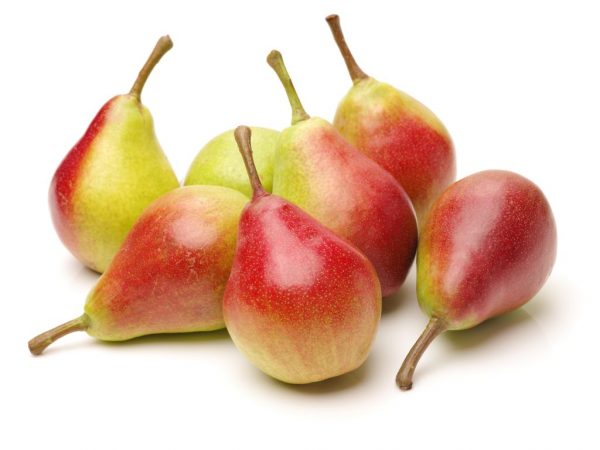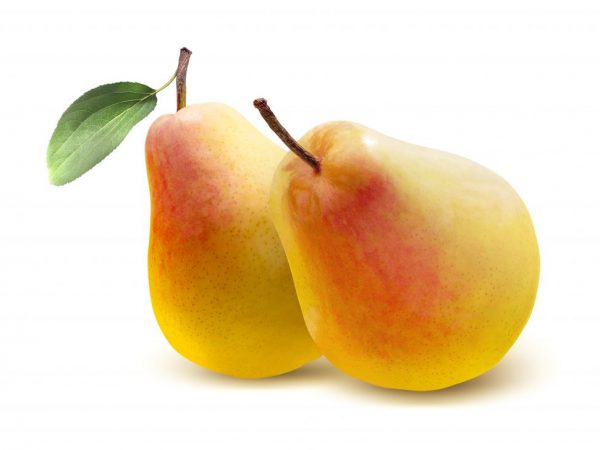Characteristics of Tikhy Don pear varieties
Pear Quiet Don has very juicy fruits with a slight sourness. The main value of the variety is large, heavy pears.

Characteristics of Tikhy Don pear varieties
Variety characteristic
Pear variety Tikhiy Don is one of the high-yielding varieties. From 1 tree can be removed from 20 to 35 kg. Fruiting is regular and occurs at an early age (2 years after planting).
One of the downsides is the need for pollinators. Quiet Don is not capable of self-pollination. To do this, it is advisable to plant other fruit trees near the pear - apple trees, peaches, cherries.
The variety is frost resistant. The fruits retain their commercial qualities even after 3 months of storage and during transportation.
Description of the tree
Low trees with a gray trunk grow up to 3 m by 10 years. Other characteristic features of this variety are:
- shoots and branches are directed upwards, located vertically;
- the color of the branches differs from the trunk with a brown tint;
- vertical shoots are red-brown in color, they are large and medium, straight and rounded;
- brown buds resemble a cone;
- pear leaves Quiet Don egg-shaped with a toothed border;
- the leaf plate is dark green, glossy;
- leaves of medium size, slightly curved upward;
- in the inflorescence there can be about 8 small white cupped flowers.
After the flowering period, fruits begin to appear. With 8 flowers, 5-6 pieces will be fruitful.
Description of fruits
The fruits are large enough. The weight of the pears is 250 - 350 g. The correct, isosceles shape resembles a blunt cone.
According to the description of the stalk of medium length, the funnel is absent. The cup has a half-open or closed shape.

Fruit of the correct shape, weight is 250 - 350 g
The pear is distinguished by a large number of subcutaneous points. Skin color is greenish-yellow with a bright crimson blush. The pulp of ripe fruits is juicy, creamy white.
Inside the fruit, there are long seeds of a rich brown hue. Slight astringency with a slight sourness gives the fruit a spicy taste.
Landing rules
In care, this type is unpretentious. It is advisable to plant this variety in the autumn.
Seat selection
The landing site is selected as sunny and spacious enough. It should be prepared at the end of August. A little compost and mineral fertilizers must be added to the hole in advance.
Sapling selection
Seedlings are selected for three years. They should have trunks with well-developed branching roots. The root system of the tree must be completely immersed in a hole more than half a meter deep.
Landing
After immersing the seedling in the hole, gently spread the roots and sprinkle the soil in which they were before planting. Only then fill up the soil and tamp the landing site. Don't forget to water it first. Remember, the neck of the plant should rise 6 cm above the ground. The distance between seedlings should not be less than 7 m.

It is advisable to plant this variety in the autumn.
Care
Watering
Newly planted seedlings require abundant watering. When planting, make a groove around the plant. This will make it easier to water and save you from washing away the roots. In the first year after planting, it is worth providing the culture with plenty of moisture.
Crown formation
Pruning must be done carefully. Quiet Don is cut off no earlier than a year after disembarkation. You need to remove those shoots that are half a meter above the soil. For the winter period, young trees are usually covered with a small layer of snow.
Diseases
The Tikhy Don variety has excellent scab resistance. It is extremely rare that a culture can be exposed to the following diseases:
- White spot or septoria. The pest appears on pear leaves with pale grayish spots with a dark brown edging. The period of plant damage falls on the end of May. You can fight this scourge by spraying the affected areas with a nitrafen solution. Prevention measures against septoria are carried out in early spring before the buds appear on the tree. The solution is prepared based on the proportion of 300 g of the drug per 10 l of water.
- Sooty fungus. Inhabits plants that inhabit leafy fleas. Appears at the places of emptying of these insects - honeydew. Covers flowers, leaves and pears with a dirty black coating. Having found the first signs, urgently treat the plant with insecticides. The affected leaves are removed.
- Fruit rot. It manifests itself in the form of brown spots on the fruit, which eventually turn into growths. Affected fruits lose their juicy elasticity, acquiring a loose consistency and become inedible. You can fight this scourge by removing the affected fruits.
Pear Quiet Don is immune to almost all diseases, however, if left untimely, it can weaken this resistance.
Pests
Pear of the Tikhy Don variety is susceptible to attack by pests - rodents and pear honeydew. Garden mice and other rodents damage tree trunks. In some cases, they gnaw through the tree more than half. When you find these pests, wrap the lower part of the trunk with thick paper. A couple of layers will be enough to create protection from rodents.
The pea sucker or leaf flea is a small jumping winged insect. Pests overwinter in the bark of a tree or under fallen leaves. Overwintered females lay 400-900 eggs, which, at temperatures above 10 ° C, become active pests in 10-20 days. When affected by this insect:
- flowers fade;
- leaves become smaller and thinner;
- the fruits take on an ugly shape, become hard.
As a result, fruits affected by leaf fleas become unfit for human consumption. The yield level drops sharply in the process.
The honeydew left behind by the insects contributes to the colonization of the sooty fungus. It is necessary to process the trunks and branches in the spring, before the buds appear, with a kerosene-oil emulsion. Spraying is carried out in the following ratio: 40 g of soap is mixed with 80 g of kerosene. This mixture is diluted with 10 L of water. This is enough to process 3-4 trees.
It is impossible to get rid of pests completely. But preventive measures can significantly reduce their number.
Conclusion
The Tikhy Don variety is a great option for those who want to decorate their garden with compact pear trees. Unpretentious care, resistance to many diseases, the luscious and juicy fruits of the dessert pear make the variety one of the most popular among gardeners.


